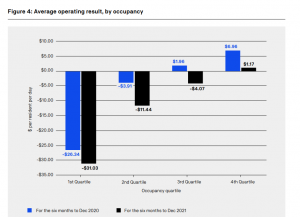Lower occupancy is driving down profitability for residential care providers, according to a new report from researchers from the UTS Ageing Research Collaborative (UARC).
The 98-page Australia’s Aged Care Sector: Mid-Year Report (2021-22) – which covers the six months ending December 2021 and is based on StewartBrown’s survey data – finds that more than 60% of residential aged care homes are operating at a loss, with an average deficit of $11.34 per resident per day.
The average total result for the surveyed providers was a $339,000 deficit as of December 2021, compared to a $544,000 surplus in December 2020 when providers had an inflow of COVID-related funding that largely ended in June 2021.
This decline in financial performance comes in spite of 99% of aged care homes receiving the Basic Daily Fee supplement (an additional $10 revenue per resident per day) since July 2021.
 One of the key drivers of the losses was the continued falls in occupancy levels.
One of the key drivers of the losses was the continued falls in occupancy levels.
Check out the graph on the right.
As you can see, homes with the highest occupancy rates achieved a modest operating surplus of $1.17 per resident per day.
In contrast, those with the lowest occupancy rates recorded an operating loss of $31.03 per resident per day.
These results were also down to relative minor differences – in December 2021, the occupancy rate at the 25th percentile (1st Quartile) was 89%, while the occupancy rate at the 75th percentile (4th Quartile) was 96.8%.
The median profit margin also dropped from 3.2% in December 2020 to 2.1% in December 2021 as providers’ costs grew faster than revenue.
Employee expenses continue to account for the lion’s share of costs, increasing 6.38% to 70.8% of operating revenue and well above the 2.03% annual growth in full-time equivalent (FTE) staff, suggesting providers are spending more on agency staff to fill workforce gaps.
Ongoing workforce shortages and the increasing number of Home Care Packages are also forecast to worsen these results over the next 18 months – see the next story.
We will examine the report’s home care results in next week’s issue.
You can read the full report here.










